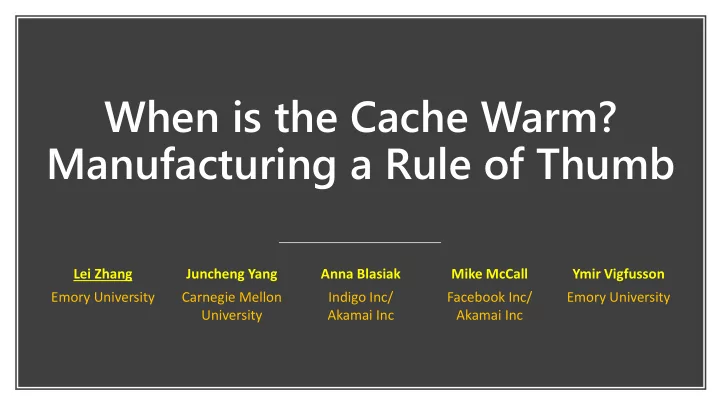

When is the Cache Warm? Manufacturing a Rule of Thumb Lei Zhang Juncheng Yang Anna Blasiak Mike McCall Ymir Vigfusson Emory University Carnegie Mellon Indigo Inc/ Facebook Inc/ Emory University University Akamai Inc Akamai Inc
Distributed Caches are Dynamic Example: Look-aside caches in web services Hit Miss Client Various dynamic operations 1. GET k • Cache partitioning, re-partitioning, load balancing • Failure recovery 3. SET (k, v) 2. GET k Cache server starts out ‘cold’ (or partly cold) Cache Warmup : Getting cache from ‘cold’ to ‘hot’ Storage 2
Understanding Cache Warmup Imagine if you’re operating some cache servers… Caches are only useful when they contain useful data Cache misses = end-users get their data slower Cache misses = expensive load on storage servers Cache has warmed up when it provides “sufficient” performance Considered by few recent works, but never carefully quantified Implicit in many designs (e.g. rate of cache repartitioning) Challenging to define and calculate Warmup is a dynamic process Static metrics (Hit Ratio) are insufficient 3
Cache Dynamics Cache performance depends fundamentally on workload dynamics We capture cache dynamics through the Interval Hit Ratio • Effectively a sliding window over hit rate. • Example: LRU, cache size = 3 IHR = 0/3 IHR = 3/3 IHR = 1/3 IHR = 1/3 IHR = 3/3 C C C C C C C C C C C C C B B B B B B E E E B B B B B A A A A A A D D D A A A A A A A B C A B C D E C A B C A B C HR = 8/15 4
IHR Original Defining Warmup New fail restart warmup time 0 Natural definition: ‘converge to original’ Assume the operation started from beginning Beats the alternatives: Arbitrary Hit Ratio threshold Arbitrary Time threshold Result: Warmup is faster than fillup • 16.6%-39.1% 5
Defining Warmup Time For cache size 𝑡 and tolerance level ϵ , a cache that recovers at time 𝑡𝑢 is considered warmed up at time 𝑢 if for any end time 𝑓𝑢 > 𝑢 , we have: 𝐽𝐼𝑆 0, 𝑓𝑢, 𝑡 − 𝐽𝐼𝑆 𝑡𝑢, 𝑓𝑢, 𝑡 < ϵ . Computing warmup time = offline analysis on IHR results • Requires future knowledge of IHRs How can we estimate warmup time in practice? 6
Solution: Rule of Thumb Practical estimation of blackbox metrics Goal: derive a rule of thumb formula for warmup time • Make it simple • Make it accurate • Make it general Estimates should fully consider cache dynamics 7
Deriving a Rule of Thumb Compute offline warmup time as defined Using spatially sampled workloads for efficiency Relax the dynamic factors Using maximum warmup time over all possible restart/recovery times Approximate static factors Cache size and tolerance level Apply (log)-linear regression for warmup time and factors, discover relationships Result : warmup-time size, 𝜁 ∝ size 𝑞 𝑡 ∙ 𝑓 −𝑞 𝑓 𝜁 Extension: enlarging cache size, e.g. for cache partitioning (see paper) 8
Evaluating the rule warmup-time size, 𝜁 = 𝑫 ∗ size 𝑞 𝑡 ∙ 𝑓 −𝑞 𝑓 𝜁 We used multiple types of workloads Simplicity: ✓ Accuracy : 𝑆 2 likelihood test score 80% as threshold of a significance fit More accurate with combined params Generality : parameter range Concentrate within each workload group 9
Applying the Rule of Thumb If your workload is similar to ours, use our formula. Otherwise follow same process as how the formula was generated: 1. Get offline simulation results with workload(s) and cache parameters (s, 𝝑 ) offline-results = SIMULATE(workloads, params) 2. Get workload specific formula warmup-time formula = ANALYZE(offline-results, params) 3. Use the formula for future operation decisions 10
Discussion How to quantify the original cache state? • Initial cache state (assumed to be stale or empty in the paper) • When we reduce the cache size, what items are evicted? Are our assumptions about cache dynamics justified in practice? • Warmup time with different recovery/restart points • Requires input from real systems 11
Conclusion Warmup time matters in distributed caches, yet rarely studied Use Interval Hit Ratio to capture cache dynamics Nifty rule of thumb formula to use in your cache server operations We plan to open source the warmup package! Thank you! Questions? geraldleizhang@gmail.com
Recommend
More recommend